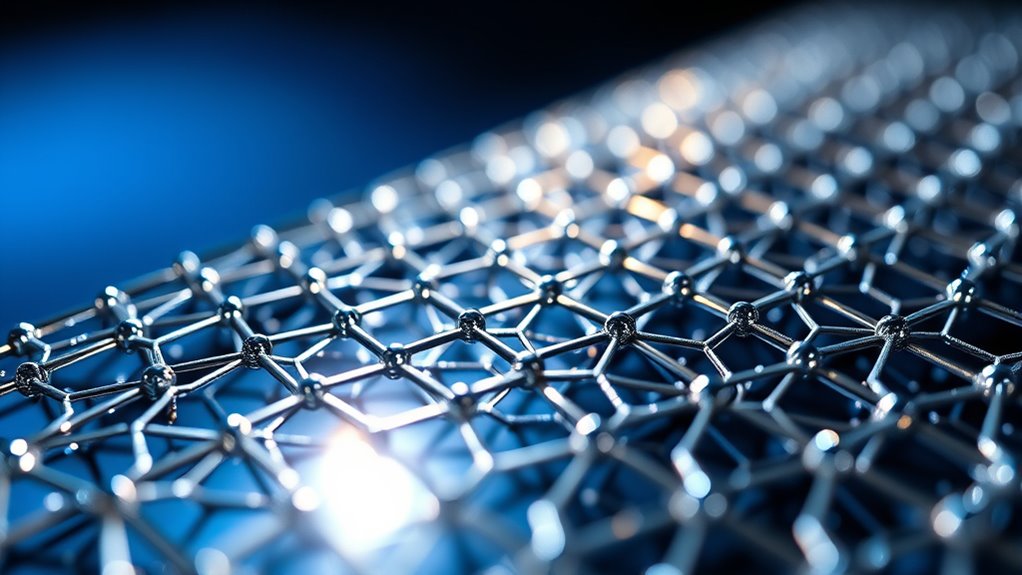Nanotechnology boosts your battery’s performance by creating nanostructured electrode materials with larger surface areas, which improve electrochemical reactions. It enhances electrical conductivity, enabling faster charge and discharge cycles. Precise control over nanomaterial synthesis allows for better durability and higher energy densities. Plus, nanomaterials help prevent degradation, extending the battery’s lifespan. Exploring these innovations shows how nanotechnology can transform your energy storage systems—discover more about how these advancements work together to power your devices efficiently.
Key Takeaways
- Nanomaterials increase electrode surface area, boosting electrochemical reactions and energy storage capacity.
- They improve electrical conductivity, enabling faster charge/discharge rates in batteries.
- Precise nanostructure control enhances electrode stability, reducing degradation and extending battery lifespan.
- Nanotechnology enables tailored morphologies that optimize ion diffusion and energy density.
- Surface modifications and coatings protect nanostructures, preventing side reactions and improving durability.

Electrode nanomaterials have revolutionized energy storage and conversion technologies by offering enhanced surface area, improved electrical conductivity, and superior electrochemical performance. When it comes to developing advanced batteries, your focus must be on optimizing nanomaterial synthesis. This process involves carefully controlling the creation of nanostructures to achieve specific properties, such as uniform particle size, high purity, and tailored morphologies. Precise nanomaterial synthesis guarantees that the electrode materials can maximize their electrochemical potential, leading to higher energy densities and faster charge-discharge cycles. As you refine synthesis techniques—like chemical vapor deposition, sol-gel methods, or hydrothermal processes—you’ll find that you can produce nanostructures with exceptional consistency and scalability, which are vital for commercial applications. Additionally, understanding the influence of wave and wind on nanomaterial stability can be crucial when considering environmental impacts during manufacturing and operation.
Incorporating nanomaterials into electrodes markedly impacts electrode durability, a key factor in battery longevity. Because nanostructured materials have a larger surface area and shorter diffusion paths, they tend to mitigate common degradation mechanisms such as cracking, delamination, or capacity fading over multiple cycles. Your challenge is to engineer nanomaterials that maintain structural integrity under repeated electrochemical stress. This often involves designing core-shell structures, flexible composites, or doping strategies that reinforce the nanomaterials’ robustness. By doing so, you enhance the electrode’s ability to withstand volume changes during charge/discharge processes, preventing deterioration and extending the battery’s lifespan.
Furthermore, the synergy between nanomaterial synthesis and electrode durability becomes evident when optimizing electrode fabrication. Controlling parameters during synthesis—like temperature, precursor concentration, and reaction time—directly influences how well nanomaterials adhere to current collectors and how resilient they are during operation. You must also consider surface modifications or coatings that protect nanostructures from side reactions and corrosion. These strategies not only improve electrode durability but also guarantee consistent performance over many cycles, which is essential for reliable energy storage systems.
Frequently Asked Questions
How Do Electrode Nanomaterials Impact Battery Safety?
You improve battery safety by using electrode nanomaterials that enhance electrode integrity and thermal stability. These nanomaterials create more durable and stable electrode structures, reducing the risk of short circuits, overheating, or thermal runaway. As a result, your batteries become safer, less prone to failures, and better at maintaining performance under stress. This makes the overall device safer for everyday use and extends its lifespan.
What Environmental Concerns Are Associated With Nanomaterial Production?
You should be aware that nanomaterial production raises toxicity concerns, as tiny particles can pose health risks during manufacturing and disposal. Additionally, resource scarcity becomes an issue because extracting and processing raw materials for nanomaterials often require significant energy and finite resources. These environmental concerns highlight the need for sustainable practices and careful regulation to minimize potential harm while advancing nanotechnology in battery development.
Are Nanomaterial-Based Electrodes Cost-Effective for Large-Scale Manufacturing?
Nanomaterial-based electrodes can be cost-effective for large-scale manufacturing despite scaling challenges and raw material costs. You might face hurdles in scaling up production efficiently, but advances in synthesis methods reduce costs over time. While raw material expenses are higher initially, increased demand and mass production can lower costs, making nanomaterial electrodes a viable option for large-scale batteries. Overall, strategic investment and innovation can offset these challenges and boost long-term affordability.
How Do Nanomaterials Influence Battery Recyclability?
Nanomaterials improve battery recyclability by making recycling methods more efficient and effective. They enable better material recovery because their small size allows for easier separation and extraction of valuable components during recycling processes. You can use advanced techniques like hydrometallurgical or pyrometallurgical methods more effectively, reducing waste and recovering high-purity materials. This not only promotes sustainability but also lowers costs, encouraging more widespread recycling of nanomaterial-based batteries.
What Are the Long-Term Stability Issues of Nanostructured Electrodes?
You should know that over 40% of nanostructured electrodes experience significant capacity fading within just 1,000 cycles due to structural degradation. Long-term stability issues mainly stem from repeated volume changes causing cracks and loss of electrical contact. This leads to capacity fading, reducing battery lifespan. To guarantee durability, researchers focus on improving nanomaterial resilience, but ongoing challenges with structural degradation still threaten their long-term performance.
Conclusion
So, next time your phone’s battery outlasts your patience, thank electrode nanomaterials. Thanks to nanotechnology’s magic, your gadgets get smaller, faster, and more powerful—almost like they’re secretly plotting to make you forget about charging. Who knew tiny particles could do such big things? Soon, we’ll be carrying batteries that last forever, and you’ll wonder how you ever survived with those boring, old electrodes. Cheers to nanotech—saving your devices one atom at a time!










